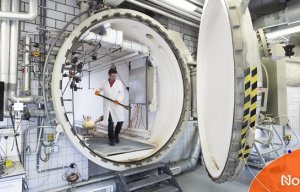
Interview with Johan Landfors, MD of polymer chemistry at Nouryon
Adam Mott, The North Face’s director of sustainability, spoke with us about ongoing and new sustainability initiatives at the company.

21st September 2015
Innovation in Textiles
|
US
Talking Heads is a brand new Innovationintextiles.com column, which features interviews with the industry’s movers and shakers. In this Talking Heads, Debra Cobb interviews Adam Mott, Director of Sustainability at The North Face.
In 2014 The North Face, part of VF Corporation’s Outdoor & Sports Coalition, reported revenues of USD$2.3bn, up 11% over the previous year. The NY Times reported that the outdoor apparel brand commanded a 25.4% share of the US market in October 2014; and with distribution in over 40 countries, around one-third of its business is international.
The company’s leadership in the outdoor space is due to quality product, of course; but is also a result of the brand’s perception among consumers. While The North Face’s positioning as a brand that helps people push their limits and explore new experiences continues to resonate, the company’s innovative and expanding sustainability program also connects strongly with consumers, particularly millennials.
Adam Mott, The North Face’s director of sustainability, spoke with us about ongoing and new sustainability initiatives at the company.
AM: The RDS is the most comprehensive, global, third-party certified animal welfare and traceability standard for down and feathers available for use by any company. Released in January 2014 with the first certificate issued in June 2014, the RDS is now working with more than 350 farms that are raising more than 100 million birds.
Our products incorporating RDS certified down are hitting the store shelves for autumn 2015; and our goal is 100% certification by autumn of 2017. Our hope is that the collective use of the RDS will effectively promote positive animal welfare conditions and traceability in the down supply chain at a much larger scale than we could accomplish alone. We firmly believe that by driving positive change across the global supply chain, the RDS will benefit the industry at large.
AM: We may not get to 100% recycled polyester by 2016, but we will achieve a significant increase. You need to have big goals. At The North Face, if you are not using recycled content, you have to come to the table and explain why.

We’re working on it, but there are performance and quality hurdles to overcome. Volume-wise there is a lot of recycled content out there, but not a lot of the specialty yarns that we want for our products. Some may not meet our aesthetic, colour fastness, or consistency standards. It’s a big equation in performance apparel—not a simple switch out.
We’re not just waiting for suppliers to come to us with solutions. We are an industry leader and working together to create an industry solution.
AM: We are heads down and spending a lot of time on chemical responsibility. For spring 2015, we’ve transitioned all our DWR to short-chain, C6 chemistry; and we are looking at how to take it further into PFC-free solutions, while trying to be responsible and make sure the replacements are not harmful. Some of these will be introduced in autumn 2015.
It feels like we’ve been researching this issue for four or five years and are now seeing it come to light. We’ve been doing a lot of testing of existing solutions as well as development work with the chemical companies to insure that any new solution meets our requirements.

We will not use a DWR treatment that does not met our quality and performance requirements. We will not put a substandard product into the market.
AM: The goal was to design and craft the garment within a 150 mile radius of our San Francisco Bay headquarters; our California cotton had to be spun in North Carolina.
We have a Backyard 2.0 version coming next spring. We want to make it better and scale up production, and are having conversations with our partners in the project—the farmers, producers, and craftsman.
It’s a question of balancing the artisanal approach with higher volume production within the US textile industry.
AM: It’s a really cool technology—kind of like science fiction. We’re looking at a lot of potential applications for it, although the technology is not yet scaled.

There are a lot of sustainability aspects. For example, the high-speed, atmospheric plasma process offers pre-treatment for improved take-up of dyes and finishes. You can save a ton of water in dyeing, and improve the efficiency of your outdoor performance treatments. We’re excited about the potential.
AM: The North Face has partnered with the bluesign system since 2008 to address the use of harmful chemicals, as well as resources such as water and energy, with 39% of our materials produced in bluesign partner facilities. As a company, VF has gone beyond bluesign by creating a corporate chemical responsibility protocol, based on demands from the brands, called CHEM-IQ.
It’s a layered approach, combining a restricted substances list, and physical testing. Every supplier—a big undertaking for all of VF—submits a full chemical inventory to us. Samples of the chemical formulations are tested and screened before being used by the textile factory.
Our commitment to cleaner chemistry and the road ahead was outlined in our recent blog post. http://neverstopexploring.com/2015/08/19/the-north-face-is-committing-to-cleaner-chemistry/

Business intelligence for the fibre, textiles and apparel industries: technologies, innovations, markets, investments, trade policy, sourcing, strategy...
Find out more